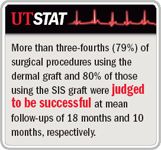Article
Less time, trauma: Porcine graft benefits Peyronie's
Atlanta-After nearly 30 years of using dermal grafts for reconstruction in Peyronie's disease, Gerald H. Jordan, MD, is switching to porcine small intestinal submucosa (SIS) as the preferred material. It was a studied decision.

"The take-home message, at least for now, is that with this early interval analysis, we are pleased with the results that we are getting with SIS and intend to keep using it," Dr. Jordan, professor of urology at Eastern Virginia Medical School, Norfolk, told Urology Times.
The study, conducted by Dr. Jordan and his colleagues, found that SIS graft (Surgisis ES, Cook Urological, Spencer, IN) netted clinical results similar to those seen with the traditional dermal graft. The team reported that 34 (79%) of 43 surgical procedures using the dermal graft and 13 (80%) of 15 procedures using the SIS graft were judged to be successful at a mean follow-up of 18 months and 10 months, respectively.
"There is no difference [in operative handling characteristics]," he said. "The difference is that one graft comes in a package, and the other buys the patient a big scar."
Dr. Jordan's group conducted the study with 58 patients with dorsal or dorsal-lateral penile curvature resulting from mature Peyronie's disease. The preoperative workup included photo documentation of the defect and sex therapy counseling.
This latter aspect of Peyronie's treatment is not insignificant. This study and others presented at the AUA annual meeting engendered a lively discussion when several physicians noted that many of their Peyronie's patients complained of shortened penile length following the procedure. Most physicians involved in the discussion said that when shortening occurs, it seldom exceeds a centimeter. Whether the shortening was real or not, the physicians concurred that complaints about it were certain to follow the procedure and should be anticipated.
"We counsel our patients and make no illusion of the fact that their penis is not going to get any longer. One of the most frequent patient complaints about Peyronie's treatment is that their penis has been shortened. I anticipate this and warn our patients up front," Dr. Jordan said.
The mean age of the patients in the series was 57 years (34 to 75 years) and the mean penile curvature was 60 degrees (range, 40 to 90 degrees). Nearly one-third (32%) of the patients recalled penile trauma, which was usual, Dr. Jordan said, according to his experience in treating the disease.
Prior to surgical intervention, pharmacotherapy was tried in 43 patients (75%), and the mean time to surgery was 3 years. Surgery involved incision/excision of the plaque and grafting of the defect with either a dermal graft (43 patients) or an SIS graft (15 patients). Surgery corrected the curvature to within 10 degrees of normal.
Postoperative complications included difficulty in voiding in three patients (5%), transient numbness or hyperesthesia of the glans in 12 patients (20%), and penile swelling in four patients (7%). Among those who received the dermal graft, two had curvature recurrence, seven had erection deterioration, and six were started on intracavernosal injections (ICI) and showed adequate response. Of those receiving the SIS graft, one man had recurrence of curvature, one reported a residual curve of 15 degrees, and one had deterioration of erection that improved with ICI.
Restored function
Ninety-one percent of patients in this study were satisfied with their ability to achieve erections with the use of pharmacotherapy, the authors reported.
"Our criteria for success are relatively rigid," Dr. Jordan said. "The patient has to have a correction of curvature such that residual curvature does not impede intercourse, and erections have to be maintained at levels that existed before the surgery."
Newsletter
Stay current with the latest urology news and practice-changing insights — sign up now for the essential updates every urologist needs.

